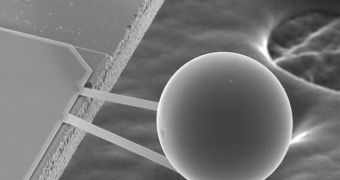A team of researchers demonstrated a way to effectively control the Casimir force, acting between two conducting plates, with a beam of light, which could lead to applications like micromachines remotely operated with a ray of light.
The Casimir force acts between separate objects, like two close parallel uncharged conducting plates and it's due to resonance of all-pervasive energy fields in the intervening space between the objects, without exchange of charge, gravity or particles.
On a submicron scale, this force becomes so strong that it becomes the dominant force between uncharged conductors. Indeed at separations of 10 nm - about a hundred times the typical size of an atom - the Casimir effect produces the equivalent of 1 atmosphere of pressure. (1.033 kg-force/cm?)
Umar Mohideen, a professor of physics in the Department of Physics and Astronomy, who led the team that made the discovery, used a ball and a flat conductive plate as the two surfaces to study the properties of the quantum nature of space.
"Where the ball and plate are close to each other, the surfaces are considered to be almost parallel at microscopic distances," said Mohideen. The ball was made of gold and had a diameter of only 200 microns and the scientist varied the material that made up the flat plate from experiment to experiment.
By comparing the Casimir force that appeared each time between the ball and a number of silicon plates having different densities, he found it to be measurably different when the carrier density of one plate was at least 10,000 times larger than the carrier density of the second plate.
"We then asked ourselves if it was possible to bring about this density difference in other ways," Mohideen said.
The second time, they used plates that had the same carrier densities as those of the ball and discovered that they were able to change the plate's carrier density by the necessary amount to change the force between the ball and the plate.
"When light is absorbed by silicon, photons are converted into positive and negative charges," Mohideen explained. "It is the increase in the number of electrons (negative charges) that increases the Casimir force. Using this result, it should be possible now to make special probes that can check for changes in electron density," he added. "It can be used, too, to make new micromachines that can be remotely operated simply by using light."

 14 DAY TRIAL //
14 DAY TRIAL //